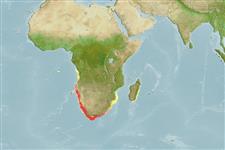Пластиножаберные (акулы и скаты) (sharks and rays) >
Carcharhiniformes (Ground sharks) >
Pentanchidae (Deepwater catsharks)
Etymology: Holohalaelurus: holos (Gr.), whole or entire, i.e., being a form of Halaeurus without any labial folds or grooves in the mouth (See ETYFish); regani: In honor of English ichthyologist Charles Tate Regan (1878-1943), Natural History Museum (London), who described many South African fishes (See ETYFish).
Eponymy: Charles Tate Regan (1878–1943) was a British ichthyologist. [...] (Ref. 128868), visit book page.
Environment: milieu / climate zone / depth range / distribution range
экология
морской батидемерсальный; пределы глубины ? - 1075 m (Ref. 75585), usually 150 - 300 m (Ref. 75585). Deep-water; 4°S - 37°S
Indian Ocean from Durban, kwaZulu-Natal, South Africa, southwards and westwards to Cape Agulhas; westward into the Atlantic Ocean; northwards to southeast of Lüderitz, Namibia.
Size / Вес / Возраст
Maturity: Lm ? range ? - ? cm
Max length : 69.0 cm TL самец/пол неопределен; (Ref. 5578)
Краткое описание
определительные ключи | морфология | морфометрия
колючие лучи спинного плавника (общее число) : 0; колючие лучи анального плавника: 0. A broad-headed catshark with crowded dark brown spots on a yellowish background, producing a net-like pattern of light lines; underside white with small black pores; no labial furrows (Ref. 5578). Specimens less than 23 cm TL blackish with white side spots (Ref. 5578).
Found on the outer continental shelf and upper slope, on or near the bottom (Ref. 244). This species has been reported to prefer temperate to cool temperate waters, but may also be found in subtropical waters; apparently prefer 200-300 m depths on the west coast and 100-200 m depths on the south coast; and, a common by catch of demersal trawlers (Ref. 75585). Feeds mainly on pelagic bony fishes, also fish offal, hagfish eggs, crustaceans, and cephalopods (Ref. 5578). Oviparous (Ref. 50449).
Life cycle and mating behavior
половая зрелость | размножение | нерест | икра | Fecundity | личинки
Oviparous, with one egg laid per oviduct at a time (Ref. 5578). Embryos feed solely on yolk (Ref. 50449).
Compagno, L.J.V., 1984. FAO Species Catalogue. Vol. 4. Sharks of the world. An annotated and illustrated catalogue of shark species known to date. Part 2 - Carcharhiniformes. FAO Fish. Synop. 125(4/2):251-655. Rome: FAO. (Ref. 244)
Статус Красного Списка МСОП (Ref. 130435: Version 2024-1)
Угроза для людей
Harmless
Использование человеком
дополнительная информация
инструменты
Специальные отчеты
Скачать в формате XML
ресурсы в Интернет
Estimates based on models
Preferred temperature (Ref.
123201): 9 - 15.8, mean 10.5 °C (based on 54 cells).
Phylogenetic diversity index (Ref.
82804): PD
50 = 0.5312 [Uniqueness, from 0.5 = low to 2.0 = high].
Bayesian length-weight: a=0.00355 (0.00175 - 0.00721), b=3.08 (2.90 - 3.26), in cm total length, based on LWR estimates for this (Sub)family-body shape (Ref.
93245).
Trophic level (Ref.
69278): 4.2 ±0.5 se; based on diet studies.
устойчивость к внешним воздействиям (Ref.
120179): низкий, минимальное время удвоения популяции 4.5-14 лет (Fec assumed to be <100).
Fishing Vulnerability (Ref.
59153): Moderate to high vulnerability (48 of 100).
Nutrients (Ref.
124155): Calcium = 8.87 [1.57, 53.86] mg/100g; Iron = 0.345 [0.073, 1.156] mg/100g; Protein = 17.2 [14.0, 20.3] %; Omega3 = 0.222 [0.091, 0.543] g/100g; Selenium = 13 [4, 40] μg/100g; VitaminA = 13.9 [3.1, 62.5] μg/100g; Zinc = 0.294 [0.145, 0.560] mg/100g (wet weight);
